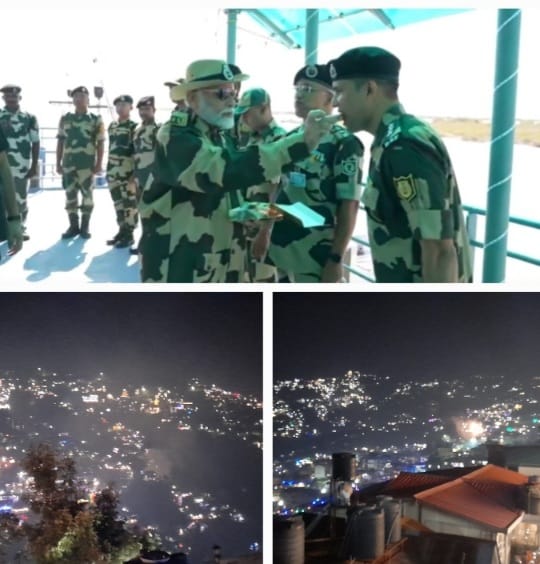Shimla: As Diwali lit up skies across the nation, Prime Minister Narendra Modi celebrated the festival in his signature style — honoring those who protect our borders.
He said Glad to have celebrated Diwali with our brave personnel from the BSF, Army, Navy, and Air Force at Lakki Nala in the Creek Area, Kutch.
This area is both challenging and remote. The days are scorching hot and it also gets cold.
The Creek area has other environmental challenges as well.This year, he joined the soldiers stationed in Gujarat's Kutch, near the border with Pakistan, sharing sweets, smiles, and spirits.
The camaraderie ran high, as soldiers stood shoulder to shoulder with their leader, lighting diyas and marking Diwali with pride and tradition.
Meanwhile, along the India-China border, a moment of mutual respect brightened up the Line of Actual Control, as Indian and Chinese soldiers exchanged sweets in a rare gesture of goodwill.
This symbolic exchange celebrated the spirit of Diwali, even in the cold rugged terrains of the Himalayas, where the festival resonates with a unique cultural fusion.
In the heart of the hills of Himachal Pradesh, Diwali takes on an ancient, ceremonial charm.
Villages like Shantha, Bateudi honor the festival with their own unique blend of lights, devotion, and tradition.
Here, Diwali melds with the age-old ritual of Jagra, a celebration that summons local Devta and stirs ancestral pride.
Rajputs visit Brahmin homes as honored guests, and by midnight, the revered deity, Kull Maharaj, steps out of the temple to bless those gathered.
Flames flicker around a large bonfire, casting shadows as the community awaits the Devta's presence with reverence.
Next day brings Padei, a day steeped in flavors and nostalgia, where Siddhu and Ghee-laden delicacies fill the air with an aroma familiar to generations in the house holds of the Badhan Rajputs.
Friends and families flock from far-flung corners to celebrate together, breaking bread and sharing stories by the fireside.
Yet, the climax of this three-day celebration lies in the thrilling Khila Baraach, a ceremonial "battle" between Rajput Badhans and Bhat Bhaats.
Perched on a hilltop, a khila — a symbolic marker crafted from the Bhaikhal bush — is set as the coveted prize.
What follows is a lively contest, where Brahmins and Rajputs alike vie to seize the Khila, an act symbolizing divine blessings for the victor.
When the Khila is claimed and flung into the air, the community cheers, and Kula Maharaj bestows his favor on the winner.
The celebration wraps up with the Devta’s sacred journey, as he travels to Shatabai Mata’s temple to reside overnight.
Devotees gather around, singing Jagra hymns, honoring the Devta before he returns in a grand palki procession to his temple treasury.
Beyond these traditional hilltop celebrations, Diwali's essence transcends borders, uniting Shimla, Dehradun, and every corner of India in a shared festival of lights.
Towns glowed with a kaleidoscope of colors, fireworks streaked the sky, and people rejoiced in welcoming Lord Ram, whom they believe to be the epitome of an ideal king.
From hilltop villages to bustling cities, Diwali illuminated every heart, once again bridging past and present, mountain and plain, warrior and wanderer.





